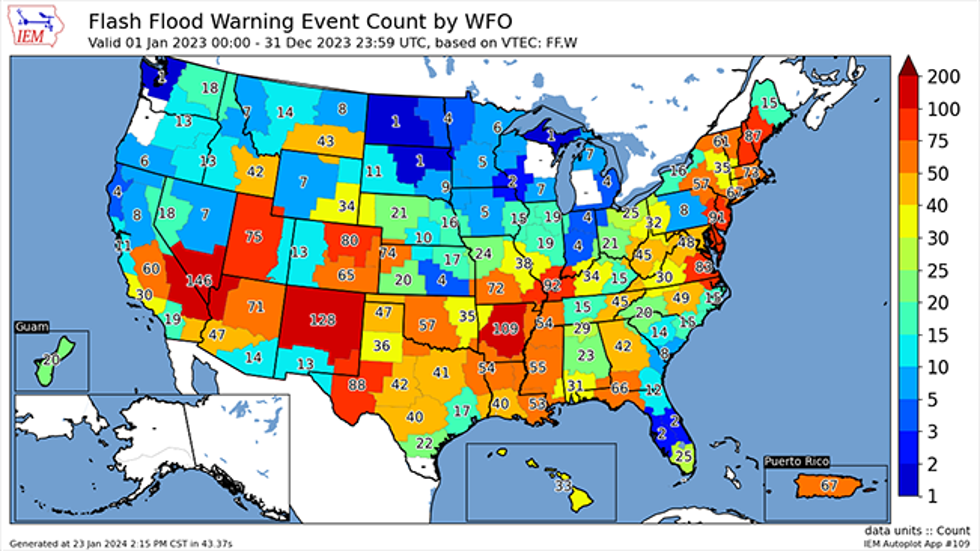Flash Flood Emergencies: Preparedness, Response, And Recovery

Table of Contents
Preparedness for Flash Floods
Proactive measures are key to minimizing the impact of flash floods. Understanding your risk and developing a comprehensive plan are the first steps towards ensuring your safety and protecting your property from flash flood damage.
Understanding Your Risk
Identifying your local flood risk is paramount. Utilize online resources like FEMA flood maps to determine your property's vulnerability to flash flooding.
- Check your property's flood history: Research past flood events in your area to gauge your risk level. Local government websites often maintain historical flood data.
- Locate your nearest evacuation routes: Familiarize yourself with the quickest and safest escape routes from your home or workplace in case of a flash flood. Plan multiple routes in case one is blocked.
- Subscribe to local weather alerts: Sign up for weather alerts and warnings from your local National Weather Service (NWS) or equivalent agency. Immediate alerts are crucial for timely response.
- Know the elevation of your property: Understanding your property's elevation relative to surrounding areas helps determine your vulnerability and the potential for floodwater inundation.
Creating a Flash Flood Emergency Plan
A well-defined plan is crucial for a coordinated and effective response. This plan should include detailed procedures for your household or business.
- Designate a meeting place outside the flood zone: Choose a safe location outside the flood-prone area where family members or colleagues can gather after evacuation.
- Pack an emergency kit: Assemble a kit containing essential supplies such as water, non-perishable food, a first-aid kit, medications, flashlights, batteries, and a portable radio.
- Secure important documents in waterproof containers: Protect vital documents like insurance policies, identification, and financial records from water damage by storing them in waterproof bags or containers.
- Make arrangements for pets: Plan for the evacuation and care of your pets in case of a flash flood. Include pet carriers, food, and water in your emergency kit.
- Learn basic first aid and CPR: Knowing basic first aid and CPR can be life-saving in the aftermath of a flash flood.
Protecting Your Property
Implementing preventative measures can significantly reduce the damage caused by flash floods.
- Elevate electrical appliances and valuable items: Move electrical appliances and other valuable items to higher ground to prevent water damage.
- Install flood barriers or sandbags: Use flood barriers or sandbags to protect entry points to your home or business. These can help divert water away from vulnerable areas.
- Clean gutters and downspouts regularly: Ensure proper drainage to prevent water from accumulating around your property. Clogged gutters can exacerbate flooding.
- Improve drainage around your property: Consider improving drainage around your home by creating channels to divert water away from your foundation.
- Consider flood insurance: Flood insurance provides financial protection against the costs associated with flood damage. Check with your insurance provider for coverage options.
Responding to a Flash Flood Warning
Responding effectively to a flash flood warning is crucial for minimizing risk and ensuring safety.
Evacuation Procedures
When a flash flood warning is issued, immediate evacuation is often necessary.
- Follow instructions from emergency officials: Obey instructions from local authorities and emergency responders. They provide vital guidance for safe evacuation.
- Never drive through flooded areas: Floodwaters can be deceptively deep and fast-moving, making driving through them extremely dangerous. "Turn Around, Don't Drown" is a crucial rule.
- Move to higher ground immediately: Seek higher ground as quickly as possible to avoid being caught in the rising floodwaters.
- Seek shelter in a sturdy building: If evacuation isn't immediately possible, seek shelter in a sturdy, elevated building.
- Avoid contact with floodwater: Floodwater is often contaminated with sewage, chemicals, and other hazardous materials. Avoid contact to prevent illness or injury.
Staying Safe During the Flood
Personal safety is paramount during a flash flood.
- Monitor weather reports continuously: Stay informed about the flash flood's progression and listen for updates.
- Stay informed through official channels: Only rely on official sources for information, such as the NWS and local emergency management agencies.
- Listen for emergency sirens and warnings: Heed emergency alerts and warnings immediately.
- Avoid downed power lines and debris: Downed power lines and debris pose significant hazards. Stay clear of these obstacles.
- Be aware of potential hazards like contaminated water: Floodwater is hazardous and should be treated with extreme caution.
After the Flood
Taking immediate steps after the flood is crucial for safety and recovery.
- Check for injuries and seek medical attention if needed: Assess injuries and seek medical attention for yourself and others as needed.
- Report damage to authorities: Report any damages to your property and infrastructure to local authorities.
- Avoid floodwaters, they might be contaminated: Floodwater remains a hazard even after the flood has receded.
- Do not enter damaged buildings: Damaged buildings may be structurally unsound and pose a risk of collapse.
- Document damage with photos and videos for insurance purposes: Thoroughly document damage to your property for insurance claims.
Recovery from Flash Flood Damage
Recovering from flash flood damage requires a systematic approach.
Assessing the Damage
A thorough assessment is the first step in the recovery process.
- Contact your insurance company immediately: Report the damage to your insurance company as soon as possible.
- Document all damage with photographs and videos: Create a detailed record of the damage for insurance claims.
- Separate damaged items from undamaged ones: Sort through belongings to separate salvageable items from those beyond repair.
- Begin cleanup efforts safely and carefully: Start the cleanup process carefully, taking necessary precautions.
Cleaning and Repair
Cleaning and repairing your property after a flash flood requires caution and careful planning.
- Use appropriate safety gear (gloves, masks, boots): Wear protective gear to prevent exposure to hazards.
- Dispose of hazardous materials properly: Dispose of any hazardous waste according to local regulations.
- Be aware of mold growth and take precautions: Mold can grow quickly in damp conditions. Take steps to prevent mold growth.
- Hire licensed contractors for major repairs: Engage qualified professionals for major repairs and renovations.
- Contact FEMA for assistance if eligible: Check your eligibility for federal assistance programs.
Seeking Financial Assistance
Explore available resources for financial assistance to aid in recovery.
- Apply for federal assistance programs (e.g., FEMA): Apply for federal disaster assistance if eligible.
- Contact your insurance provider for claims: File insurance claims promptly and follow the process.
- Explore local and state assistance programs: Investigate local and state programs designed to assist flood victims.
- Consider charitable organizations for help: Many charitable organizations provide assistance to those affected by natural disasters.
Conclusion
Flash floods pose a significant threat, but with proper preparation, swift response, and effective recovery strategies, their impact can be mitigated. By understanding your risk, developing a comprehensive flash flood emergency plan, and knowing the steps to take before, during, and after a flash flood event, you can significantly improve your safety and resilience. Remember to stay informed about local weather conditions and always prioritize your safety. Don't wait for a flash flood warning—prepare for a flash flood today and protect your family and property.

Featured Posts
-
 La Premiere Mise Au Point Sur La Potentielle Suppression De La Semaine Des 5 Heures
May 26, 2025
La Premiere Mise Au Point Sur La Potentielle Suppression De La Semaine Des 5 Heures
May 26, 2025 -
 The Psychology Of Disappearance Understanding The Victims And Perpetrators
May 26, 2025
The Psychology Of Disappearance Understanding The Victims And Perpetrators
May 26, 2025 -
 How Sarah Vine Handled Her Whats App Controversy
May 26, 2025
How Sarah Vine Handled Her Whats App Controversy
May 26, 2025 -
 Eddie Jordan Ultima Hora Sobre Su Fallecimiento
May 26, 2025
Eddie Jordan Ultima Hora Sobre Su Fallecimiento
May 26, 2025 -
 Moto Gp Kembali Ke Brasil Sirkuit Ayrton Senna Di Goiania Siap Tampung Balapan 2024
May 26, 2025
Moto Gp Kembali Ke Brasil Sirkuit Ayrton Senna Di Goiania Siap Tampung Balapan 2024
May 26, 2025
Latest Posts
-
 Fridays Euro Millions Draw E245 Million Jackpot Live Updates
May 28, 2025
Fridays Euro Millions Draw E245 Million Jackpot Live Updates
May 28, 2025 -
 Euro Millions Friday Draw Follow The E245m Jackpot Live
May 28, 2025
Euro Millions Friday Draw Follow The E245m Jackpot Live
May 28, 2025 -
 Live Euro Millions Draw E245 Million Jackpot Up For Grabs This Friday
May 28, 2025
Live Euro Millions Draw E245 Million Jackpot Up For Grabs This Friday
May 28, 2025 -
 Claim Your 300 000 Euro Millions Winnings Five Days Left
May 28, 2025
Claim Your 300 000 Euro Millions Winnings Five Days Left
May 28, 2025 -
 Irish Lottery Winners Lucky Break E5k Prize Multiplied To E255k
May 28, 2025
Irish Lottery Winners Lucky Break E5k Prize Multiplied To E255k
May 28, 2025
